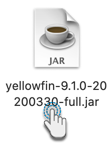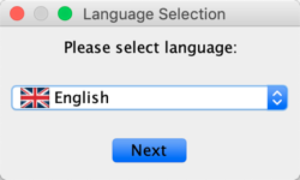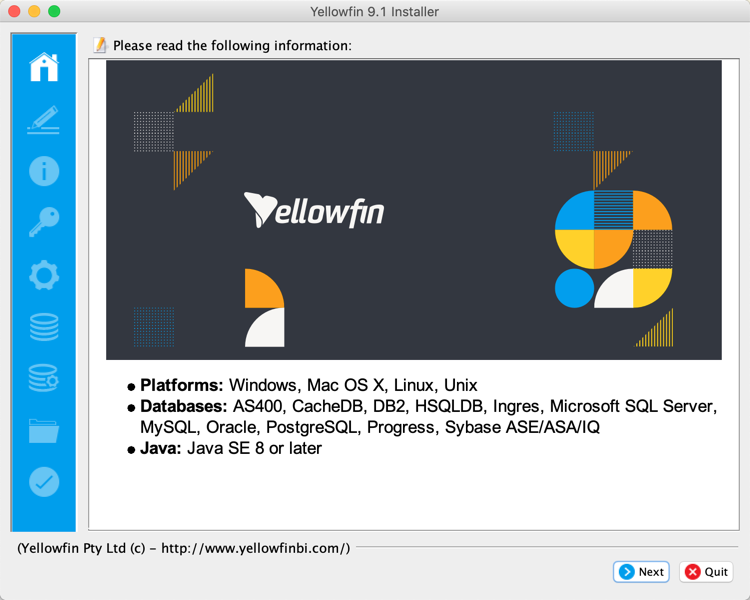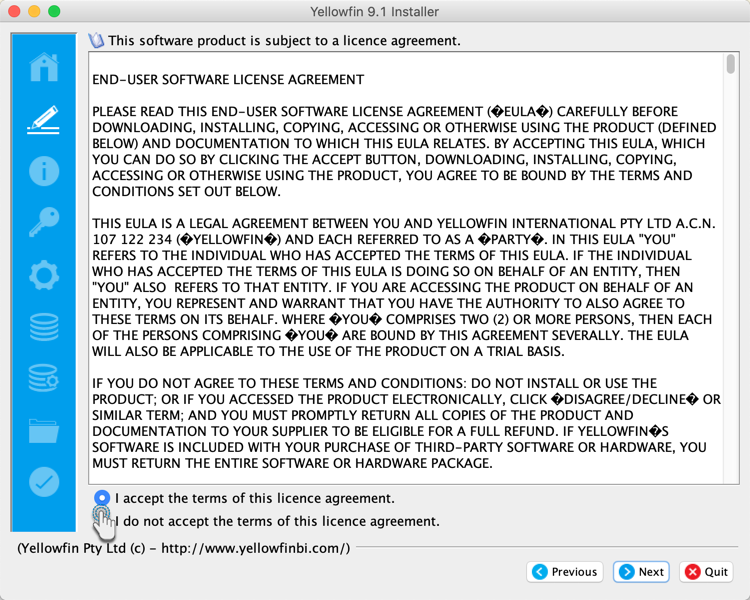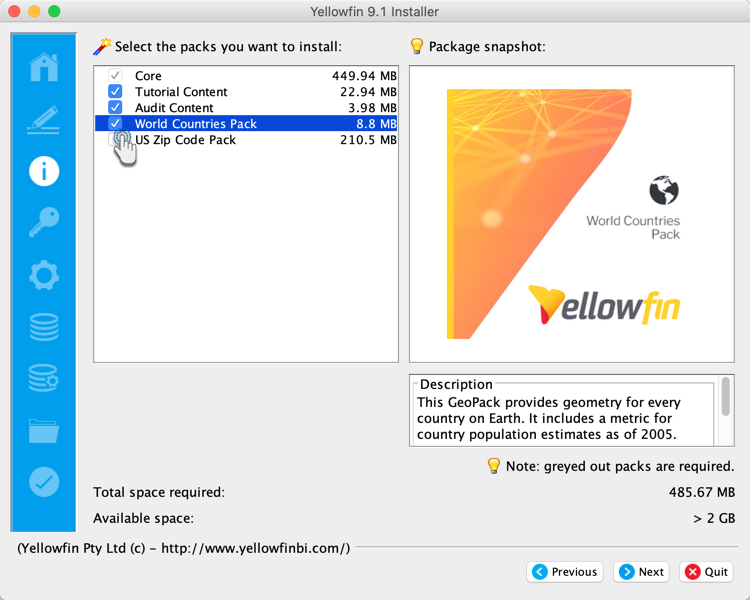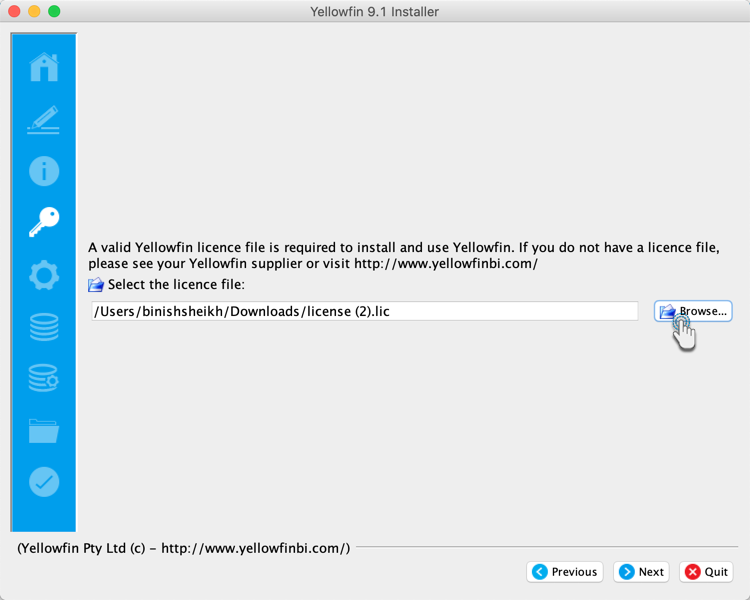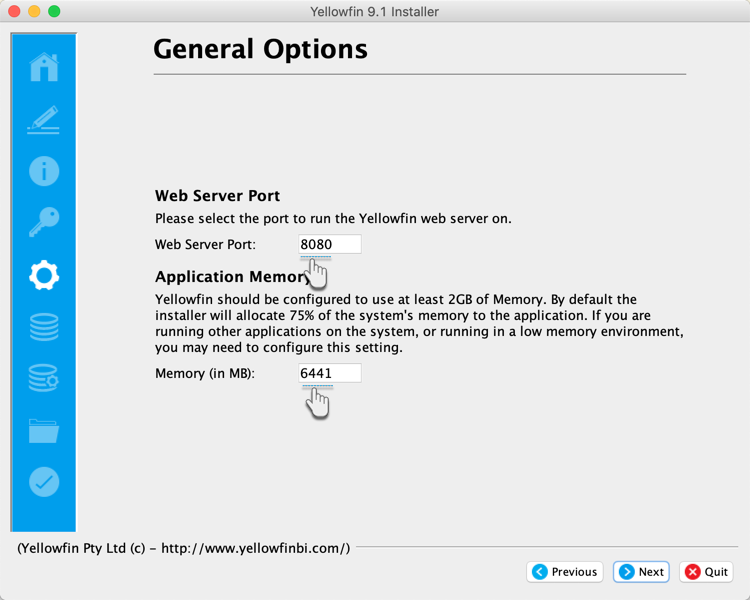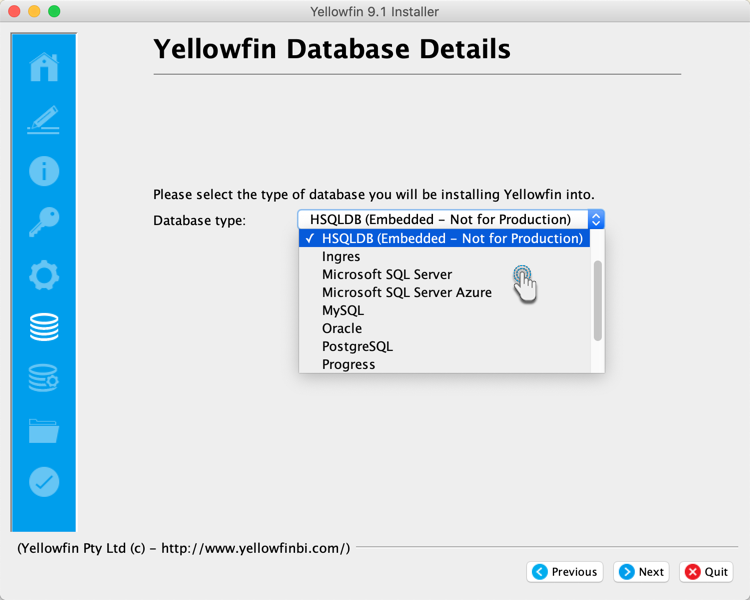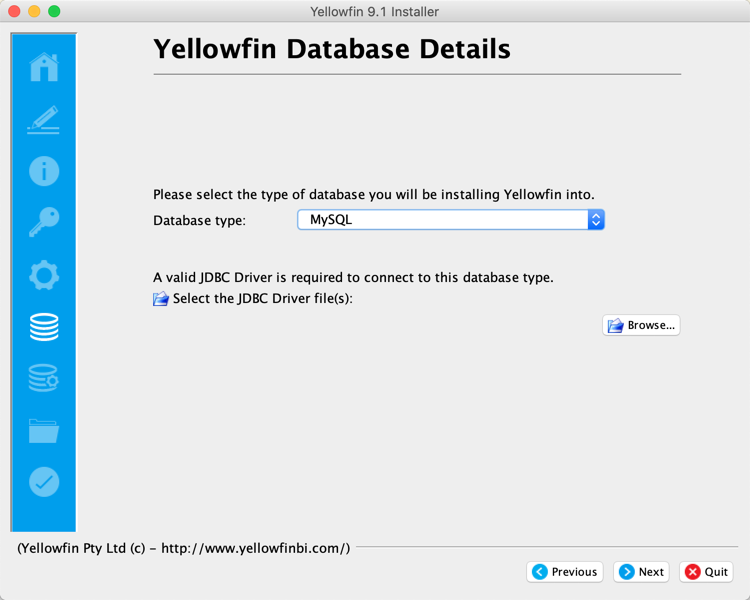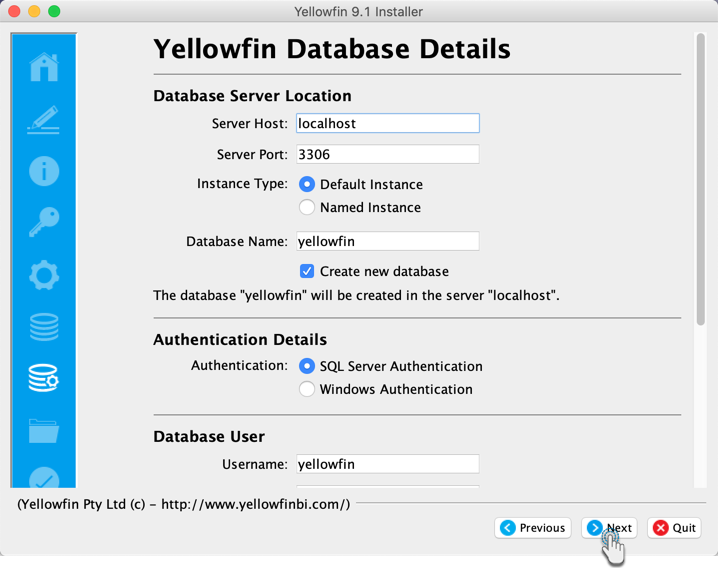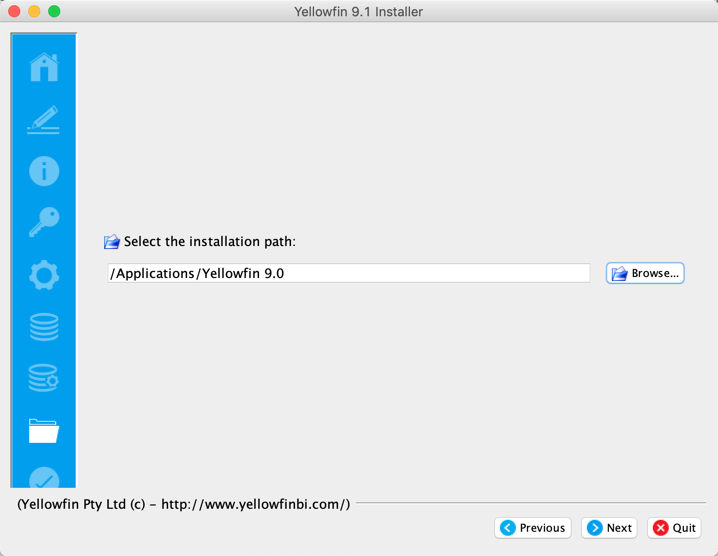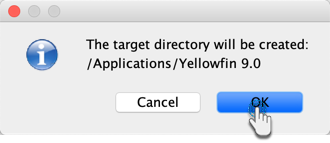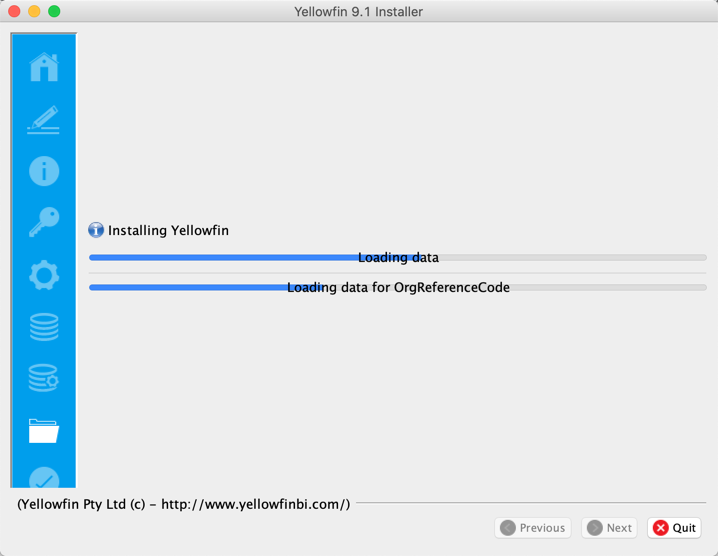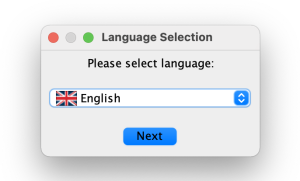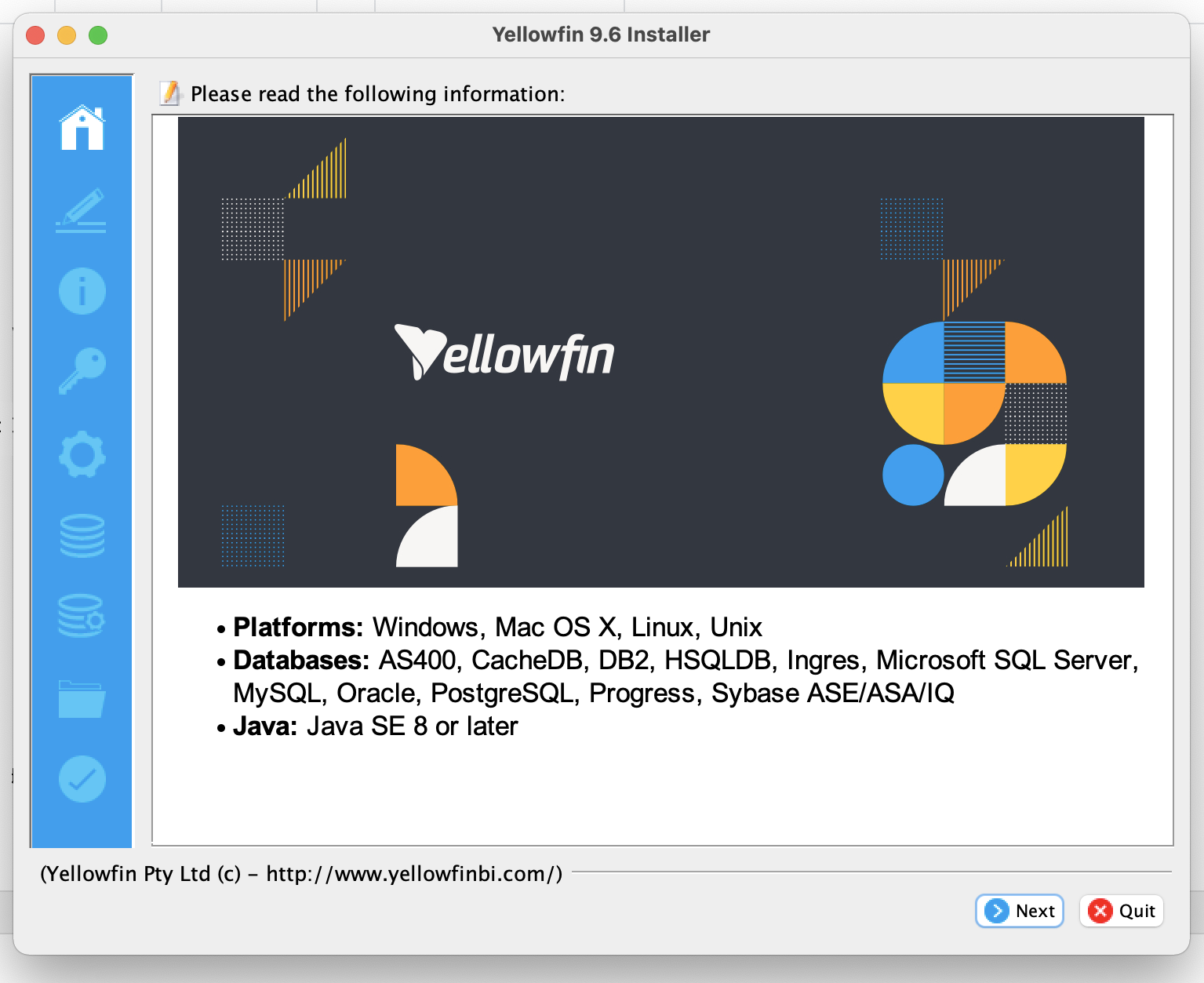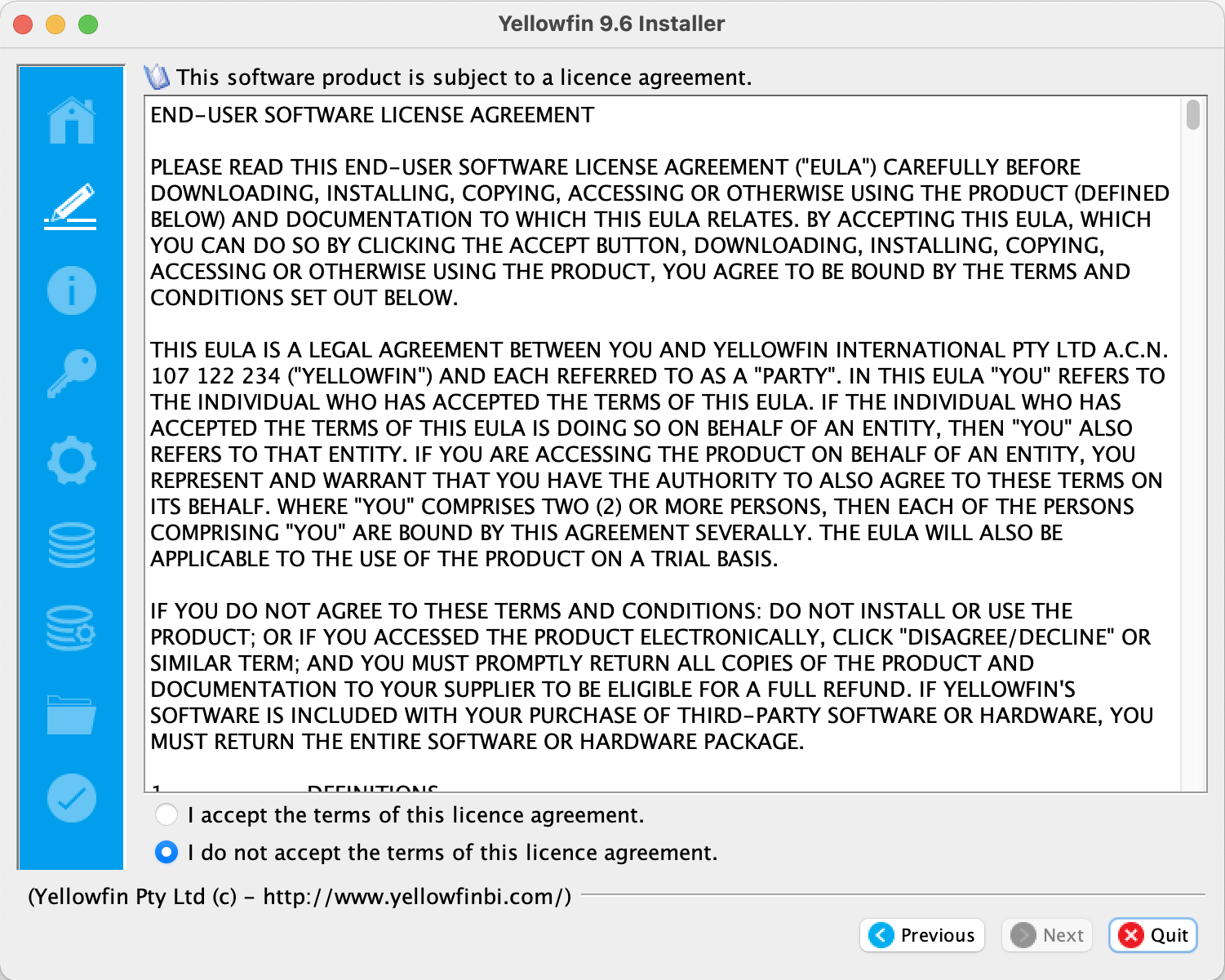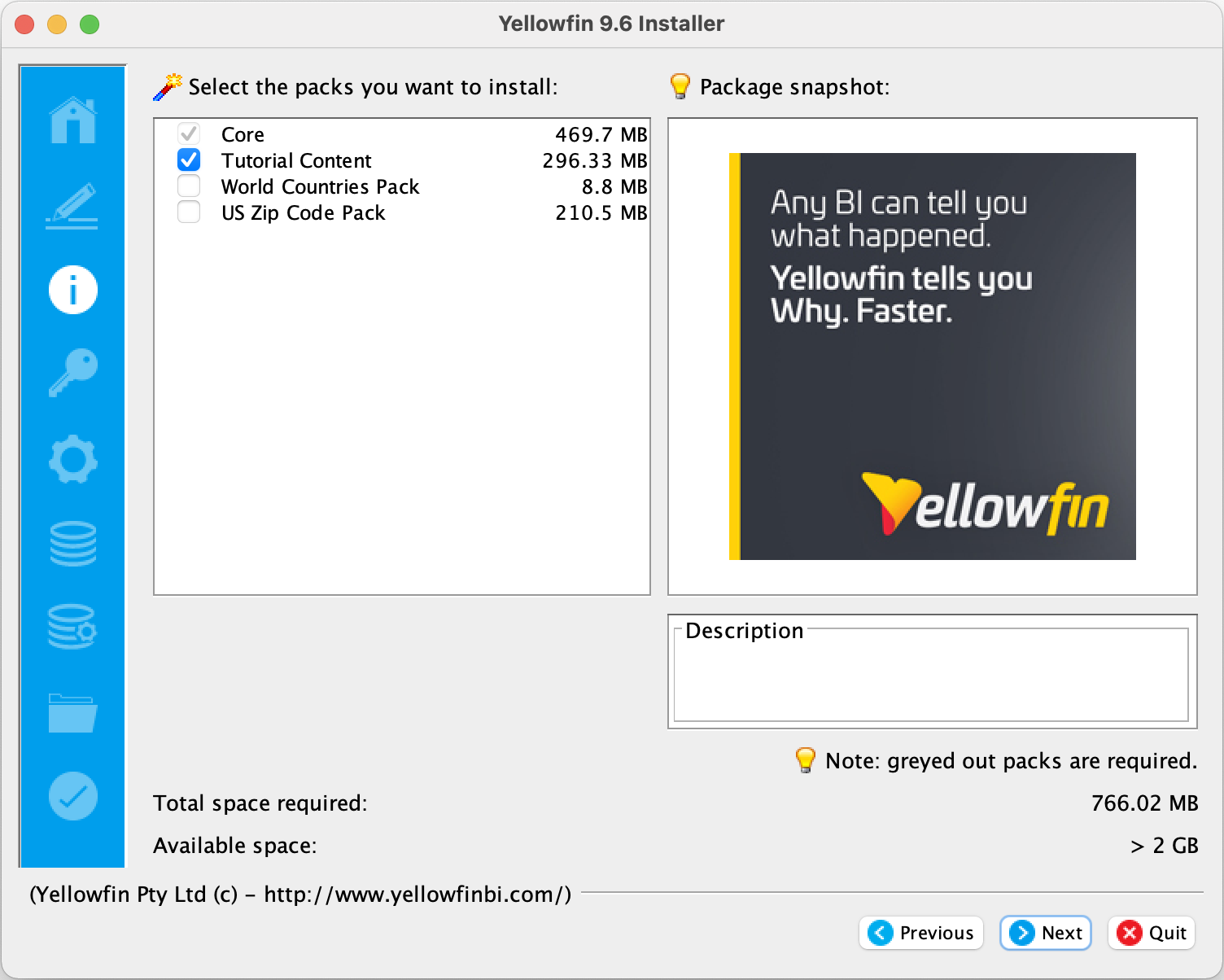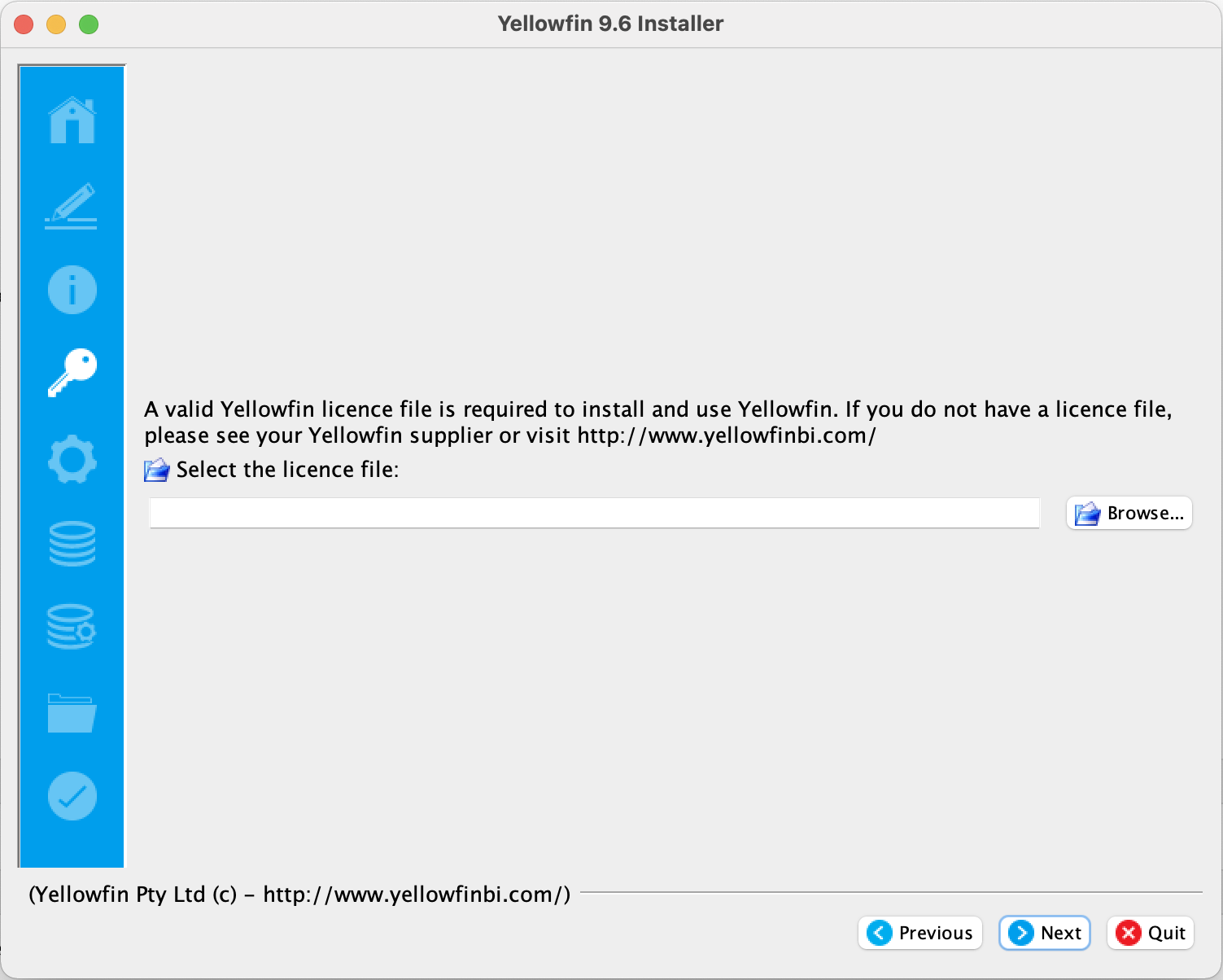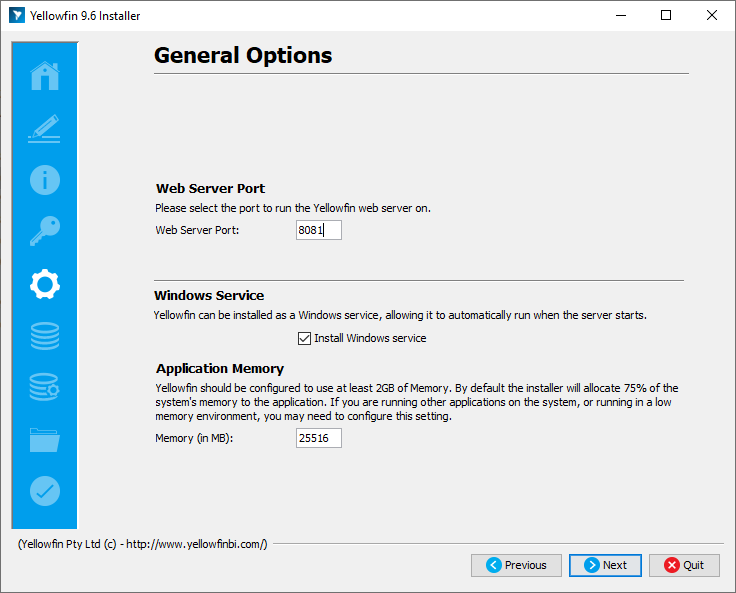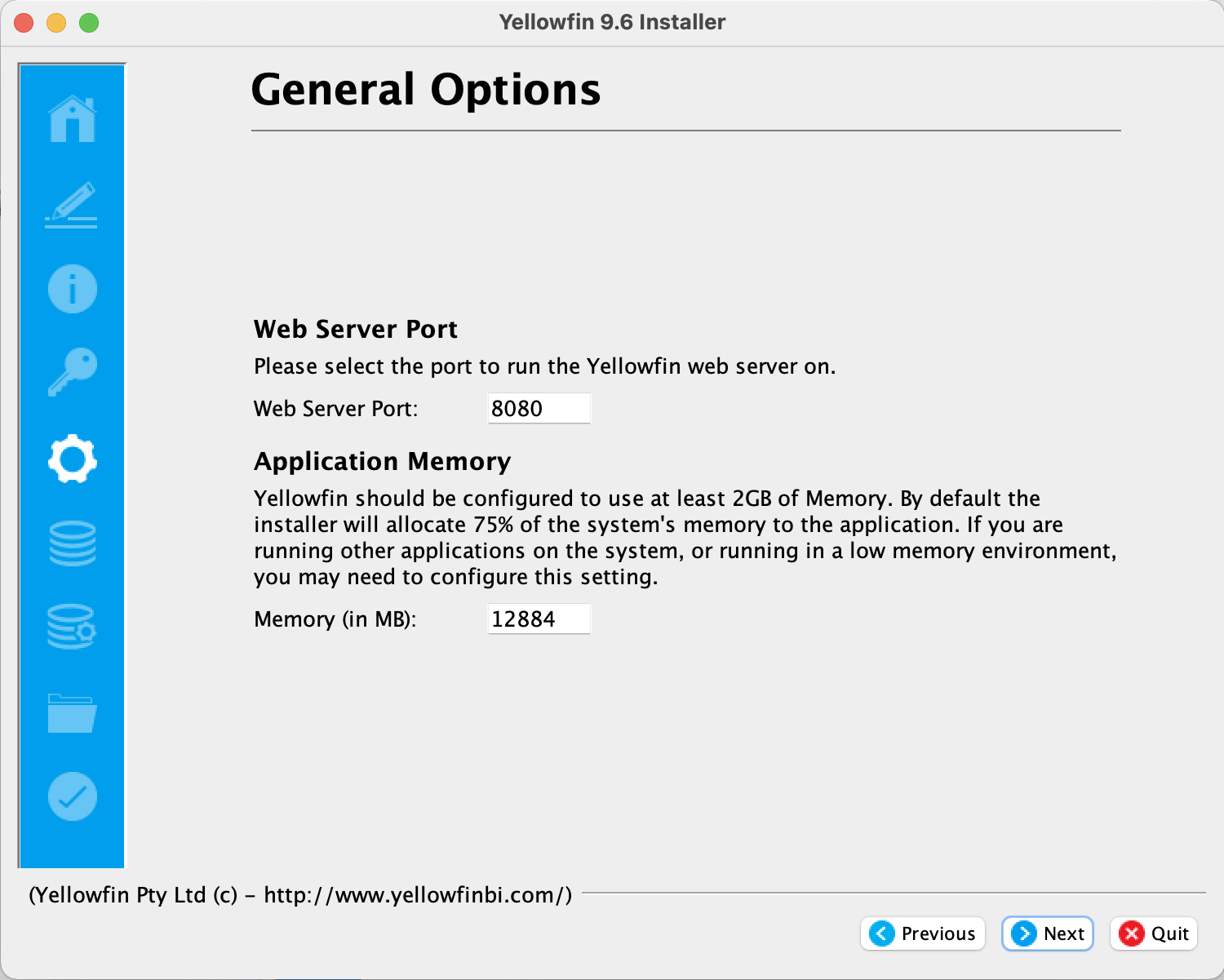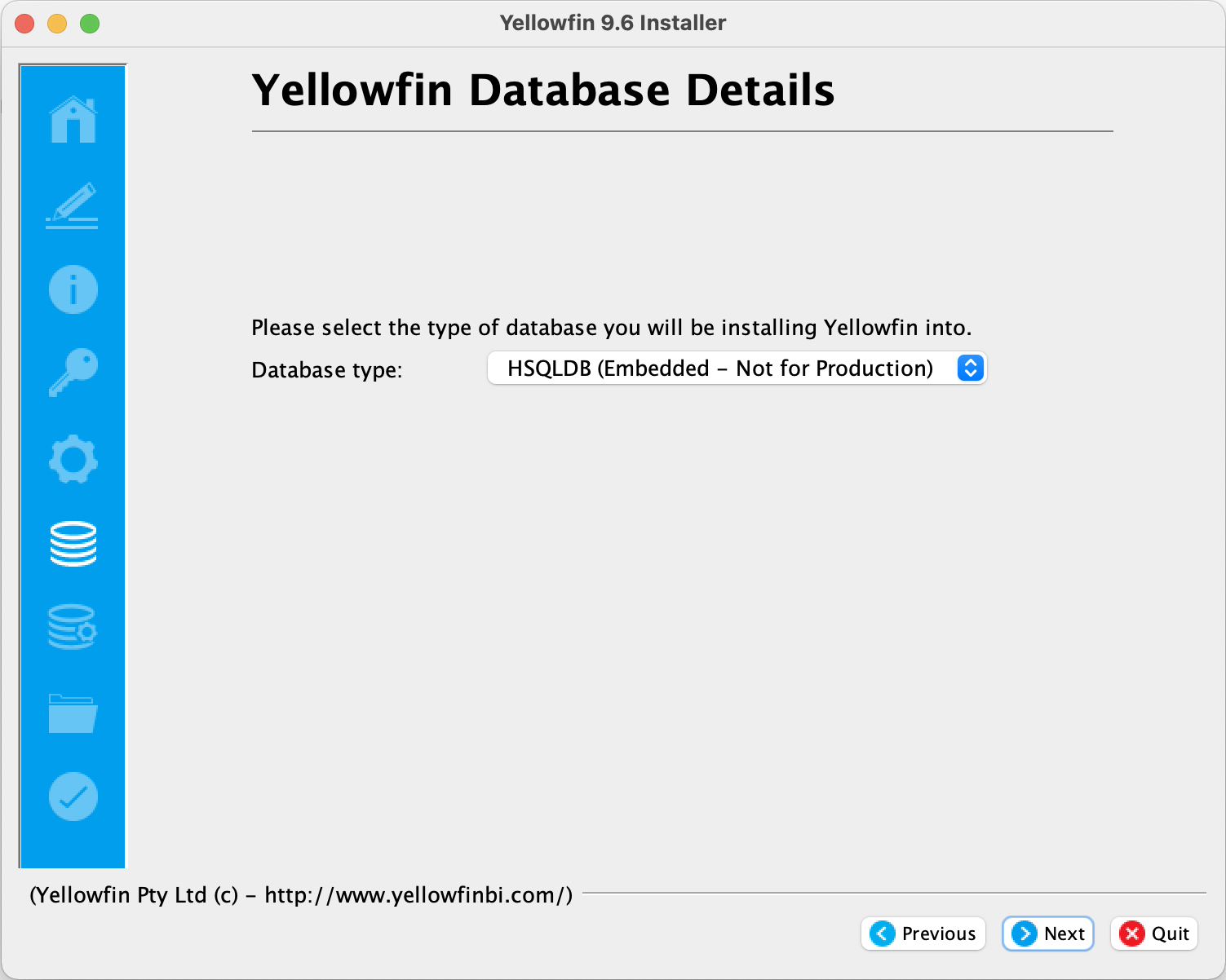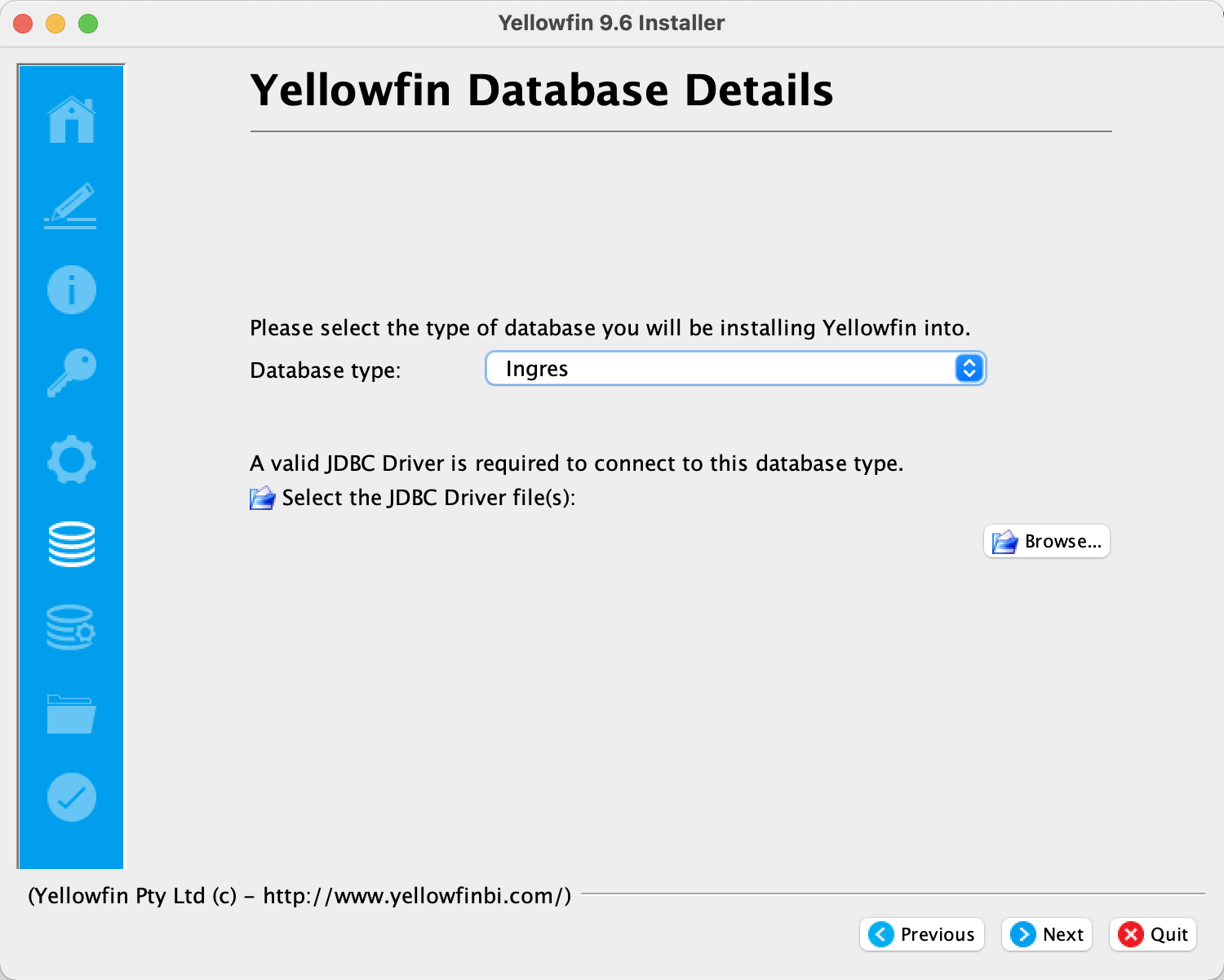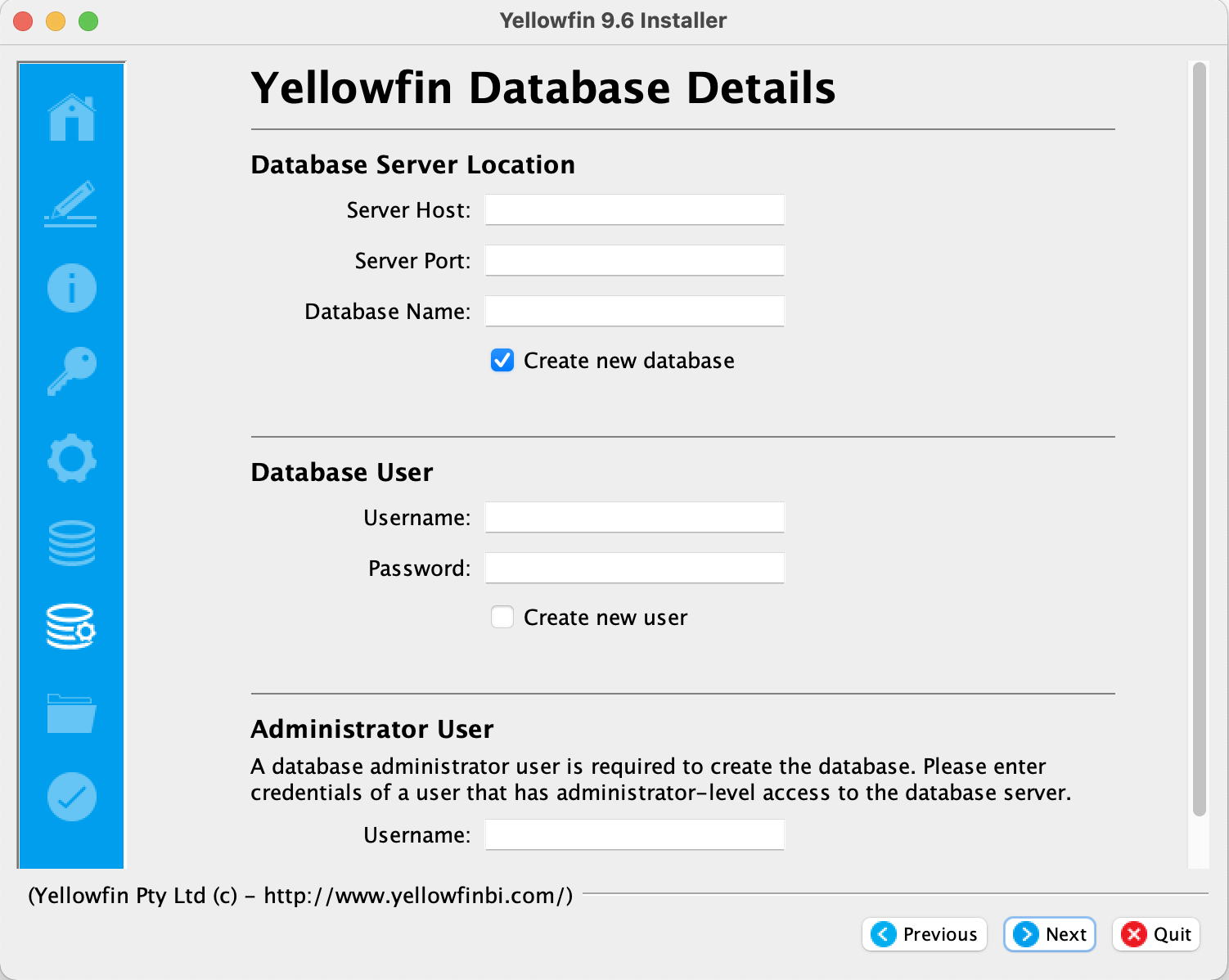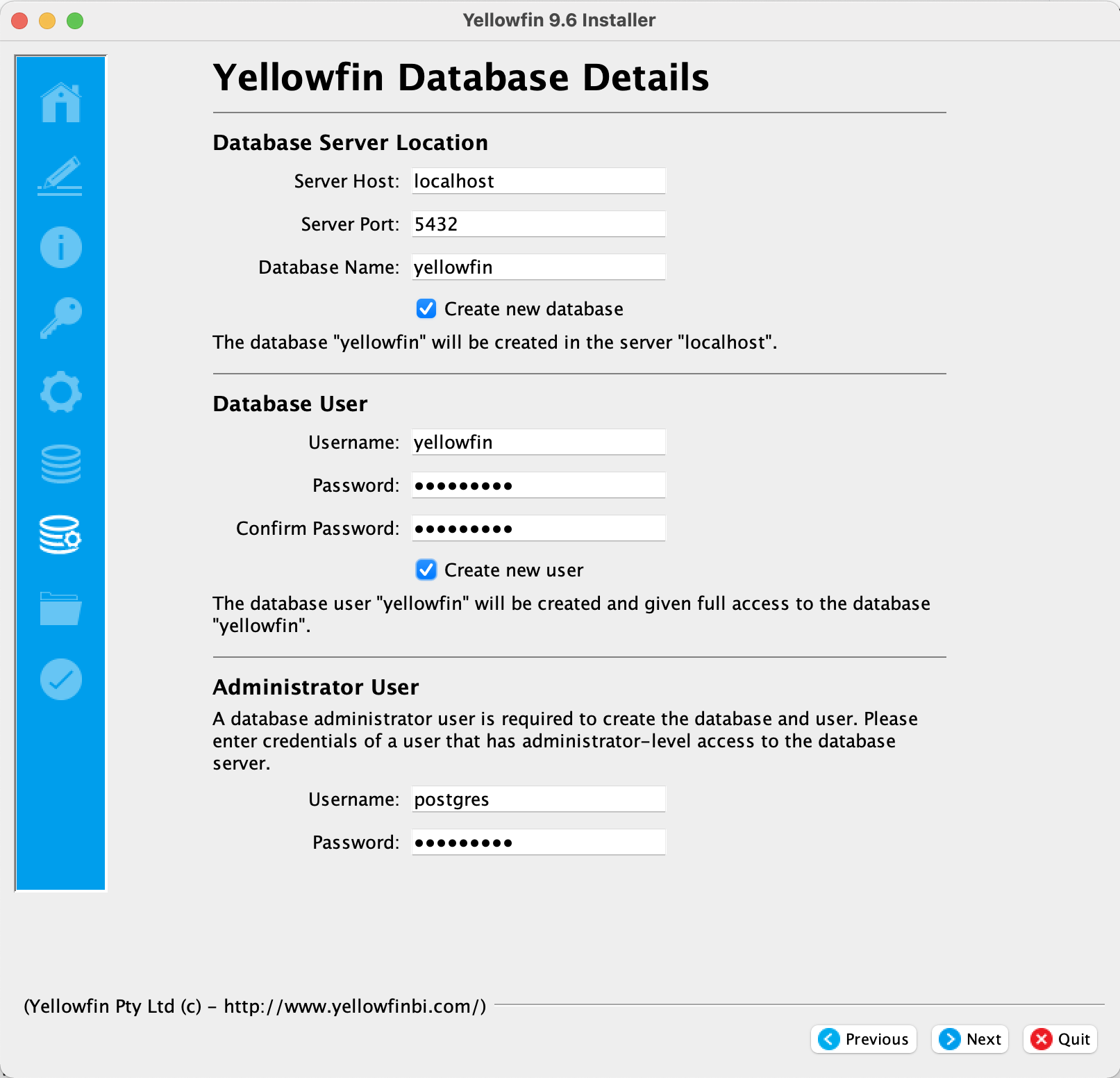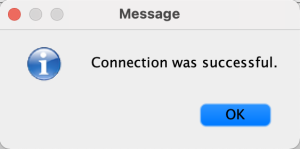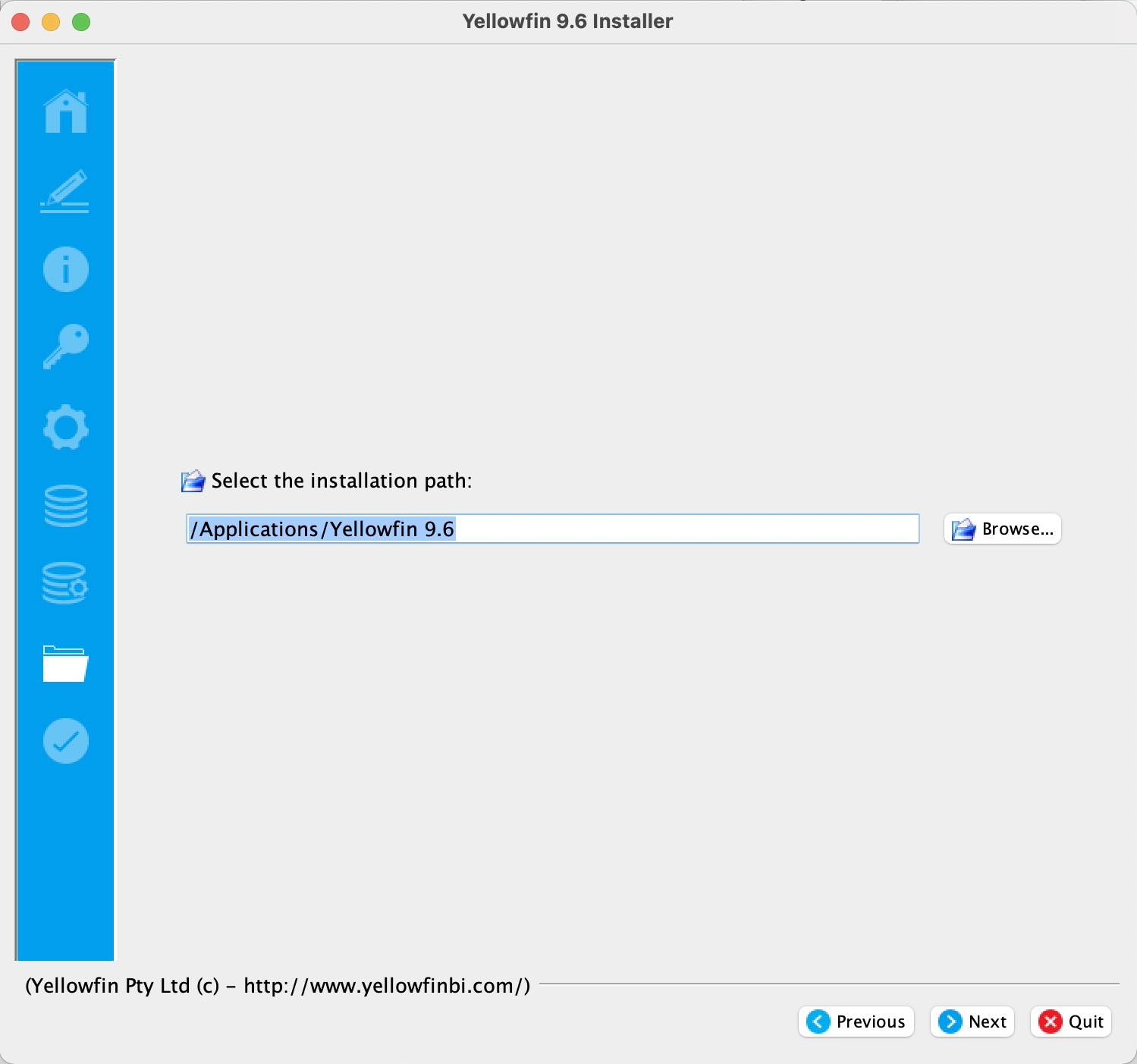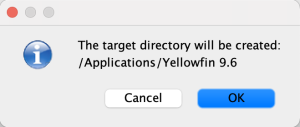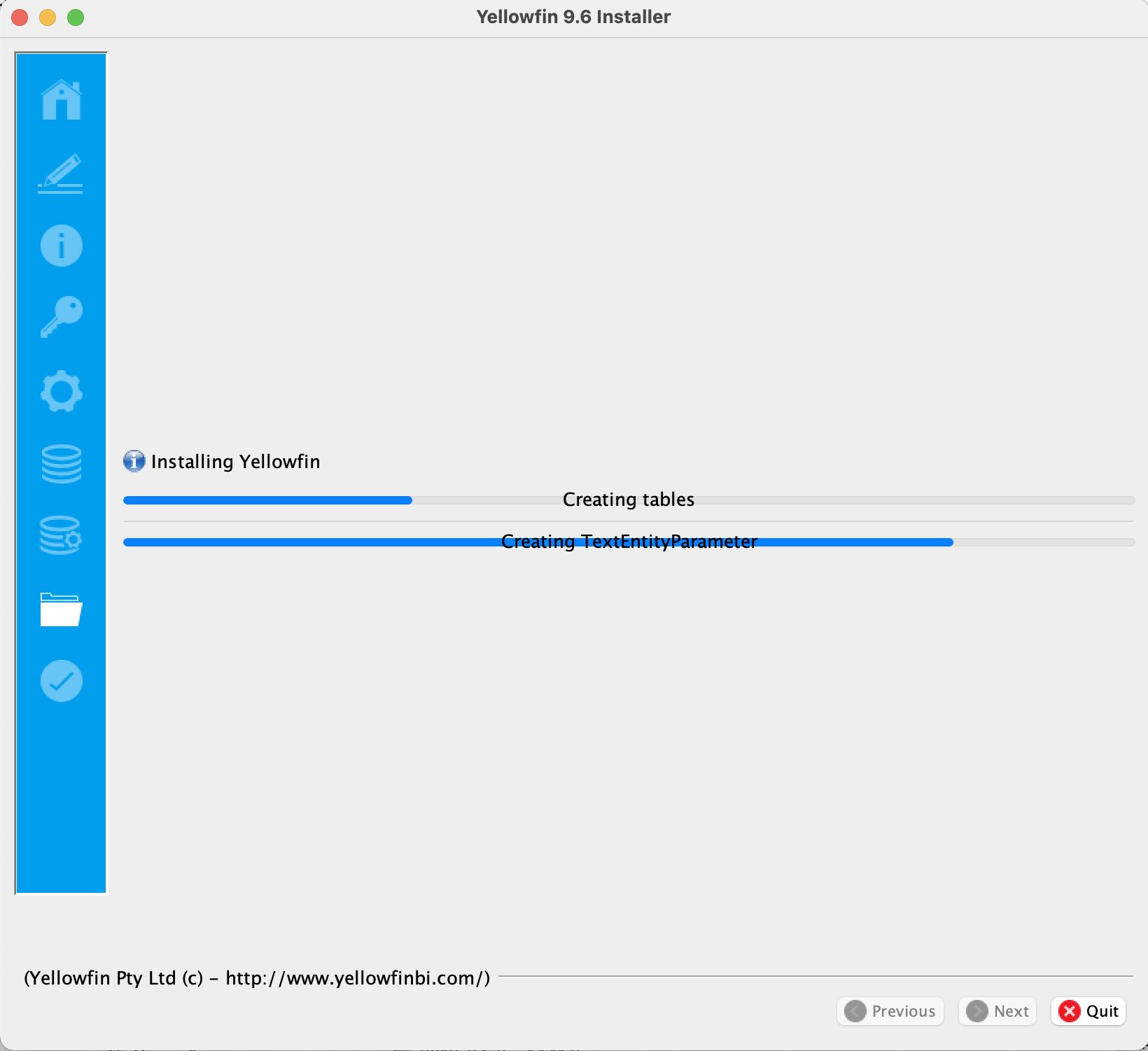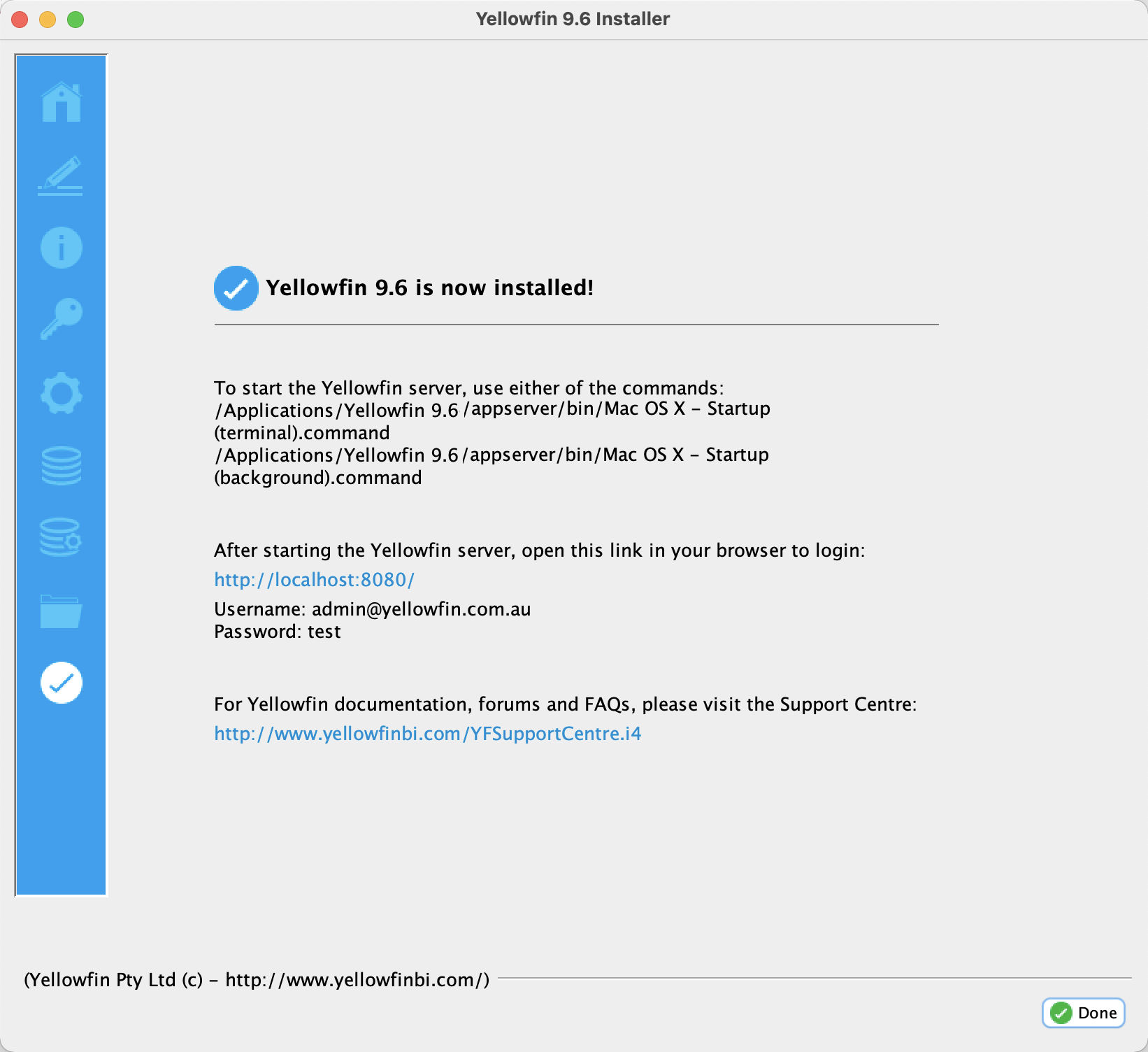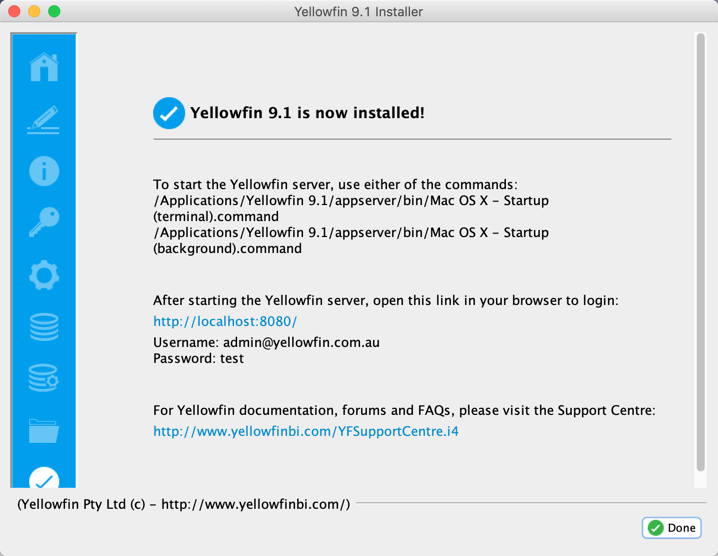Page History
...
| Table of Contents | ||
|---|---|---|
|
Installing Yellowfin
Once you have all the required software and components ready, initiate the installation process.
| Note |
|---|
See here for a list of prerequisites required to begin installation. |
Step 1: Run Installer
...
| width | 50 |
|---|
Run the Yellowfin installer as an administrator from its copied location.
- On a Linux or Mac OS X platform, run the .jar file to start the installer. (As shown in the example image.)
- On a Windows platform, run the .exe file to start the installer.
| Column | ||
|---|---|---|
| ||
Step 2: Language Selection
...
| Column | ||
|---|---|---|
| ||
Before you can begin you will be asked to select a language for the installation process. |
| Column | ||
|---|---|---|
| ||
Step 3: Welcome Screen
...
| Column | ||
|---|---|---|
| ||
The welcome screen mentions installation prerequisites and other information. Review the platforms, databases, and Java information, and click the Next button to continue, or click the Quit button at any time to exit the installation process. |
| Column | ||
|---|---|---|
| ||
|
Step 4: Terms & Conditions
...
| width | 50 |
|---|
The terms and conditions page lists the Yellowfin Software License agreement.
| Info |
|---|
The full text of the Yellowfin End-User Software Agreement can be downloaded in PDF format from here. |
When you have read the license agreement, select the "I accept the terms of this license agreement" option to agree and click the Next button to continue.
| Column | ||
|---|---|---|
| ||
|
Step 5: Components to Install
...
| width | 50 |
|---|
Overview
The Yellowfin application installer provides a traditional installation file that can be used on premises or on the cloud, via Linux, Windows and MacOS.
Before you begin the installation process, make sure you have followed the pre-requisites explained in detail on the Install And Deploy Yellowfin wiki page. This includes information about license file options and the download location of the application installer. Make sure you have downloaded the installer for your operating system before beginning these steps.
The installer will provide a series of prompts for information and confirmations. These are:
- installer language selection;
- welcome screen;
- terms & conditions confirmation;
- components to install (see table below);
- license file location;
- general configuration settings (see table below);
- database selection;
- database details (see table below); and,
- installation path (see section below).
Once you've provided the required information, the installer will indicate the progress of the installation until completion.
| Anchor | ||||
|---|---|---|---|---|
|
Additional content pack details
You can select the optional content packs to install. We strongly recommend that you install all content packs if you're installing Yellowfin in an evaluation and training setting
...
. The available packs include:
| Pack | Description |
|---|---|
Core | This is the core software for Yellowfin that must be installed. This is the minimum package required during installation. |
Tutorial Content | This content pack contains Ski Team sample data, views, reports and dashboards that are used in the Yellowfin training and help documentation. |
...
Audit Content
...
This is particularly useful if you haven't used Yellowfin before. | |
World Countries Pack | This GeoPack provides selected geographic data for every country on Earth. It includes a metric for country population estimates as of 2005. |
US ZIP Code Pack | This GeoPack provides selected geographic data for states, counties and zip codes in the United States. It includes census-derived demographics for population by age, as well as various demographics for area income, labour force and unemployment. Note: Due to the US Census Bureau's method of converting zip codes to areas there is not 100% correlation of postal zip codes to census collected data. As |
...
a result, there are zip code level land areas for which no data is available. |
You will have to install the core software for Yellowfin but you do have the option of installing the tutorial database, sample usage reports, and language translation files.
Tips:
- If you are installing Yellowfin in an evaluation and training environment, it is recommended that you install all content packs.
- If you are installing Yellowfin in a production environment, it is strongly recommended you install the Audit Content pack so you can more easily monitor the use and performance of your Yellowfin system.
After selecting components, click the Next button to continue.
| Anchor | ||||
|---|---|---|---|---|
|
General configuration details
| Column | ||
|---|---|---|
| ||
Step 6: License File
...
| width | 50 |
|---|
Next, select the license file that you received from Yellowfin by clicking on the Browse button and locating it. Once selected, click the Next button to continue.
| Note |
|---|
You can skip this step and upload the licence file after installation, after logging in. See the License Management page for details on how to do that. |
| Column | ||
|---|---|---|
| ||
Step 7: General Options
...
| width | 50 |
|---|
...
| Configuration | Description |
|---|---|
| Web Server Port |
...
Set the port number for Yellowfin to |
...
listen for web browser requests. By default, all web browsers send requests using port 80. |
...
If there are no other web servers on the machine that Yellowfin is being installed on, you can accept the default port number of 8080. If there are already web servers installed on the machine that Yellowfin is being installed on, then there may be port clashes and Yellowfin will fail to function correctly. Therefore, the port number must not currently be in use by any other application on the machine. Port numbers like 8080, 8081 and so on are typically good candidate port numbers. |
| Windows Service |
...
Check this box to install |
...
Windows Service on the server. This means that it will automatically start up whenever the Windows Server is booted and save having to be manually started. Note: this option will only appear during installation on a Windows platform. |
| Application Memory |
...
| Specify a memory size (in MB) that should be used by Yellowfin. Yellowfin should be configured to use at least 2GB of memory. By default, the installer will allocate 75% of the system's memory to the Yellowfin, but this size can be changed here. |
After configuring these value, click the Next button to continue.
| Anchor | ||||
|---|---|---|---|---|
|
Database details
The database details required during installation are for
| Column | ||
|---|---|---|
| ||
Step 8: Database Selection
...
| Column | ||
|---|---|---|
| ||
Choose the database type that you wish to install the Yellowfin Repository database into. This selection is based on the database information covered in the prerequisites. Based on your selection the next few steps will vary. Click the Next button to continue. |
| Column | ||
|---|---|---|
| ||
...
| Column | ||
|---|---|---|
| ||
If the JDBC driver of your selected database is not packaged with the Yellowfin installer, then an additional step is required to upload the driver. Click on the Browse button and choose the location where the driver is stored. |
| Column | ||
|---|---|---|
| ||
Step 9: Database Details
...
| width | 50 |
|---|
...
the database that stores all the Yellowfin content definitions, configuration information, and event details (ie, not your report data). This database can be created before the installation or the Yellowfin installer can create it
...
for
...
you
...
.
Database Server Location | |
|---|---|
Server Host | Enter the network address of the database server hosting the Yellowfin database. If the Yellowfin database is on the same computer as the Yellowfin application, enter localhost. |
Server Port | Enter the network port number of the database hosting the Yellowfin database. |
Database Name | Enter the name of the Yellowfin database. If one doesn't exist, enter a new name. |
Create New Database | If the above database does not exist on the database server, tick this option to allow the Yellowfin installer to create a new database to host the Yellowfin database using the database name entered above. When you |
...
check this |
...
checkbox, the Administrator User section will appear on the screen for you to add these existing details so that Yellowfin is granted access to create the new database. | |
Authentication Details | |
|---|---|
Authentication | This configuration is specific to Microsoft SQL server. Choose how the database users should be authenticated. Options include:
|
Logon Domain | If Windows authentication is selected, |
...
specify a logon domain. | |
Database User | |
|---|---|
Username | Enter the name of the database server user account that has access to the Yellowfin database. This database user must have full read and write permissions to the Yellowfin database. |
Password | Enter the password of the database server user account that has access to the Yellowfin database. |
Confirm Password | Re-enter the password of the database server user account that has access to the Yellowfin database. (This is only required if creating a new user.) |
Create New User | If the above database user does not exist on the database server, tick this option to allow the Yellowfin installer to create a new database user account to access the Yellowfin database. When you tick this option, the Administrator User section will appear on the screen for you to add these existing details so that Yellowfin is granted access to create a new user. |
Administrator User | |
| This section appears if you | |
...
| check the checkbox for Create New Database and/or Create New User |
...
| . | |
Username | Enter the name of the existing database server user account that has administrator-level access to the database server hosting the Yellowfin database. |
Password | Enter the password of the existing database server user account that has administrator-level access to the database server hosting the Yellowfin database. |
...
| Anchor |
|---|
...
| width | 50 |
|---|
...
...
| Column | ||
|---|---|---|
| ||
After providing the details, click on the Next button. You will have the option to get your database connection details validated. Click Yes if you wish to do so to confirm a successful connection, otherwise choose No. Proceed to the next step. |
| Column | ||
|---|---|---|
| ||
Step 10: Installation Path
...
| width | 50 |
|---|
Define the installation directory for Yellowfin. This will default to different directories based on the operating system you are installing to. For example, C:\Users\Administrator\Yellowfin 8.0.
You can change the default installation directory by directly typing in a new path, or using the Browse button to navigate the file system.
When you have chosen your installation destination, click the Next button to continue.
Notes:
|
Installation path
The Yellowfin application installer will suggest an installation path. It should be suitable for most installations, but please consider the following points before using the default.
- If the installation path does not exist just enter the required installation path and the installer will create the directory.
...
- On Windows, if you select an installation directory in the path C:\Program Files
...
- , the Yellowfin application must always be run as an administrator.
- On Windows
...
- 64bit version
...
- , ensure
...
- you choose a path outside of the Program Files directory.
- Choosing an installation path without
...
- spaces or punctuation characters will make future advanced configuration easier.
| Styleclass | |||
|---|---|---|---|
| column
| ||
| width | 50 | ||
| Section |
| Column | ||
|---|---|---|
| ||
If the installation path is new, click OK to confirm that the new directory will be created. |
| Column | ||
|---|---|---|
| ||
Step 11: Installation Progress
...
| Column | ||
|---|---|---|
| ||
This screen will enable you to observe the progress of the software installation. Depending on the capacity of the computer hardware and the content pack you selected, this could take a few minutes. When the installation is complete the Yellowfin installer will automatically move to the Installation Complete screen. |
| Column | ||
|---|---|---|
| ||
Step 12: Installation Completion
...
| width | 50 |
|---|
...
Install Yellowfin
The steps below cover the full installation process.
- Open the application installer file (the .jar file for MacOS or Linux, or the .exe file for Windows: see Install And Deploy Yellowfin for further details)
The Language Selection prompt for the installation process will be displayed - Select your preferred installer language from the dropdown, then click on the Next button to display the Yellowfin Installer, with a list of environment tools required before installation
The icons on the left indicate where you are in the installation process - Ensure you have installed the required supporting software listed, then click on the Next button to continue to the terms and conditions
The Yellowfin end-user software agreement is also available as a PDF for download - When you have read and understood the terms, click on the I accept the terms of this licence agreement radio button, then click on the Next button
Apart from the core application, a number of content packages are available for installation - Check any of the boxes for any content packages you wish to install, then click on the Next button
You will be prompted to locate your license file
If you haven't already received a Yellowfin license, learn how to request a license here - If you're waiting on your Yellowfin license, leave the box blank and add it later (see the License Management page); otherwise, click on the Browse button to locate your downloaded license file
- Click on the Next button to continue to the General Options section of the installer
If you're installing onto Windows, the Windows Service option will be added
If you're installing onto Mac OS or Linux, the Windows Service option is not displayed - Either accept the defaults, or refer to the table above for more information, then click on the Next button
The Yellowfin Database Details section will be displayed - Click on the dropdown to select your database type: based on your choice, the installation steps from here may differ (some drivers are included with Yellowfin and some are not — see the Install And Deploy Yellowfin page for full details)
If you've chosen a database that Yellowfin doesn't include drivers for, you will be prompted to locate your driver files - Select any driver files using the Browse button, if prompted
- Click on the Next button to continue adding more database details
This screen won't appear if you chose the database type HSQLDB (Embedded - Not for Production) from the list, and might contain slighty different options for different database types: this screen shows the PostgreSQL options - Using the table at the top of this page for reference, fill in the fields (here's an example)
- Click on the Next button
The installer will ask you if you'd like to validate your credentials - Select Yes to validate or No if you're sure your credentials are correct (we recommend you select Yes)
If you chose to validate and it was successful, the installer will display a confirmation message - If the confirmation message is displayed, click on the OK button to continue
The installer will ask where you'd like the Yellowfin application to be installed - If you don't wish to accept the default location (see the Installation path section for more info), use the Browse button. to select a different location
- Click on the Next button, which will display a prompt to confirm the directory location
- Click on the OK button
The Yellowfin installer will begin the installation process (the time it takes depends on your hardware capacity and the packs you selected for installation)The Yellowfin installer will display the Installation Complete screen if the installation is successful: it contains some useful information
If you do not see this screen, contact your Yellowfin representative or contact Yellowfin Support
...
, or see the Troubleshooting section below
- If you do see this screen, take note
...
- of the information provided on this
...
- scree that provides details of how to start the Yellowfin application, and the information you need to log in to Yellowfin from a web browser
...
- Click
...
- on the Done button to complete the installation
...
- process
| Note |
|---|
An uninstall function has been created for you under the directory nominated in the database selection step. Next, you must start Yellowfin to log into it. See our Post Installation section for more on this. |
| Styleclass | ||
|---|---|---|
| ||
What next?
Now that Yellowfin is successfully installed on your machine, it's time to deploy. Visit the Deploy Yellowfin page for full details and instructions for a first-time deployment of Yellowfin and the minimal configuration needed.
| Styleclass | ||
|---|---|---|
| ||
| Column | | |
|
Troubleshooting
Most problems related to the Yellowfin application server installation relate to database connectivity and administration issues.
...
Section navigation
| Section | |||||||||||||||||||||||||||||||||||||||||||||
|---|---|---|---|---|---|---|---|---|---|---|---|---|---|---|---|---|---|---|---|---|---|---|---|---|---|---|---|---|---|---|---|---|---|---|---|---|---|---|---|---|---|---|---|---|---|
Current topic -Installation StepsInstall on PremisesThis page is part of the Install And Deploy Yellowfin section of the wiki, which has these topics:
|
| Styleclass | ||
|---|---|---|
| ||
